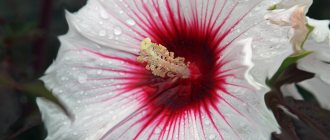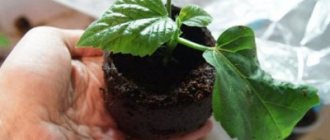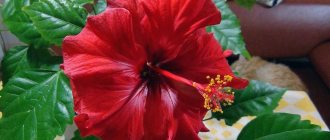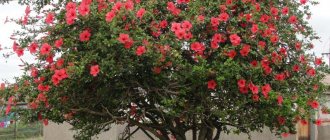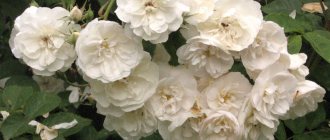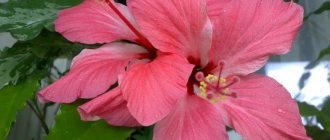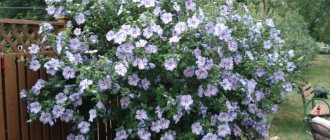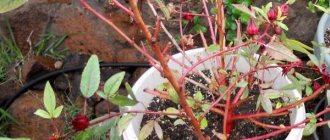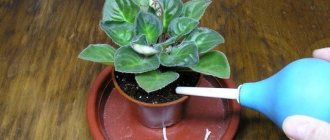Numerous species of hibiscus (Hibiscus) belong to the Malvaceae family. The homeland of these plants is Southeast Asia. The most common forms of hibiscus are shrubby and tree-like, but there are also annual herbs among them. Hibiscus has many names - Chinese rose, Sudanese rose, red sorrel, kenaf, Chinese rose, marsh mallow, etc. Flower growers respect hibiscus for its amazing flowers. Simple, semi-double and double single hibiscus flowers can reach 16 cm in diameter. And the palette of shades of Chinese rose is multifaceted - from bright red to pale yellow.
Hibiscus flowers are a symbol of the island of Haiti, a flower of the bride in India and simply a flower for women and girls. Today, breeders have developed the most beautiful forms of hibiscus.
Rosan or Chinese hibiscus (Hibiscus rosa-sinensis)
This type of hibiscus is called Chinese rose. The flowers of this plant from a distance look a little like a rose, but the rose has little in common with the queen of flowers. Chinese hibiscus is most common in indoor culture, especially its dwarf forms. Growing roses at home is not difficult.
Indoor roses are valued for their unpretentiousness, fairly fast growth and beautiful flowers. The leaves of hibiscus are simple dark green, glossy on top with teeth along the edge.
Chinese hibiscus flowers are large, single or semi-double and come in a variety of colors: orange, yellow, bright red, pinkish or pure white. Sometimes they meet
The fused stamens, elongated into a long tube, give the flowers a unique and even exotic appearance.
The exotic appearance is given to the flowers by numerous threads of golden stamens, fused into a long tube extending far from the petals. Hibiscus petals can be heterogeneous in color, with fancy coloring - strokes, streaks, a border or an eye on the petal.
Hibiscus or Chinese rose. Care and maintenance
Of the numerous variety of species of the Malvaceae family, one of its most striking representatives is widespread in indoor culture - the Chinese hibiscus (Hibiscus rosa-sinensis), which, due to its popularity, has received a lot of popular names: Chinese rose, Chinese rose, indoor rose, hibiscus (the last use is incorrect, because .k. the well-known drink is obtained from another type of hibiscus - the Sudanese rose).
The indoor rose tree comes from the tropics of the Malay Archipelago, where throughout the season the temperature does not drop below 22 degrees, which is quite consistent with the climate of our apartments, which is why caring for a Chinese rose at home is not particularly difficult, but still has some peculiarities.
Hibiscus care
Rosan, home care . If the temperature of the apartment fully meets the requirements of a tropical guest, then the air humidity and the amount of light, especially in winter, may be insufficient. In this case, spraying or installing special humidifiers, as well as additional lighting, will help, especially if the plant is already large and stands away from the window. Optimal indicators : humidity -70%, lighting - at least 1500 lux. Hibiscus does not like stuffy rooms, but when ventilating, you need to make sure that there is no draft and frosty air does not fall on the delicate leaves.
If it is impossible to organize lighting, then the Chinese rose must be kept cool (14-16 degrees), and watering reduced to a minimum, otherwise the plant will begin to turn yellow and intensively shed its leaves, and may not bloom in the future.
Water hibiscus abundantly in summer and moderately in winter as the top layer of soil dries. Water should not stagnate in the pan; it is better to avoid pots with automatic watering. From March to October, roses are fed 2 times a month with fertilizers for flowering plants, alternating root and leaf fertilizers, combined with flowering stimulants (Bud, Pollen, etc.), in winter, it is better to give the plant rest; apply no more than 2-3 fertilizing without nitrogen.
Hibiscus transplantation and propagation
In the spring, around April-May, the Chinese rose is transplanted into large flower pots (young plants once a year, adults once every 3-4 years), it is necessary to ensure good drainage and a not too heavy substrate - you can add a little river sand to the purchased soil for flowering plants and charcoal in a ratio of 5:1:1. At the same time, the plants are pruned and shaped—extra shoots that do not allow light to penetrate into the crown are removed, elongated branches hanging down and weighing down the crown are trimmed by 1/3. Semi-lignified and lignified cuttings remaining after pruning are perfect for propagation - remove the lower leaves from cuttings 10-15 cm long, soak in a solution of root or heteroauxin for 30 minutes, then place in a container with clean water at room temperature in a bright place, protected from drafts; When third-order roots appear, the plant can be planted in the ground.
Hebiscus pests
If you have an indoor Chinese rose, caring for it will not exclude timely pest control , which can easily be obtained as a bonus when purchased in supermarkets or local state farms. At first they are not noticeable, because... in the trading floors they are still in the egg or larval stage, but the dry hot climate of our apartments and offices provokes their rapid development and in just a month you can get colonies of spider mites, whiteflies, scale insects, thrips, mealybugs, as well as some soil pests. Therefore, we strongly recommend that you carry out prophylaxis with insecticides immediately after purchase; this can protect your pets from prolonged treatments with not always useful preparations and loss of the decorative appearance of the plant.
As primary prevention, you can use biological drugs (for example, Bitoxibacillin), and then regularly, at least once a month, inspect and shower or treat the crown with a soap solution.
If the recommended maintenance conditions are met, pests will have much less chance of surviving and reproducing, and a healthy and well-groomed plant will thank you with lush flowering and emerald foliage. Despite possible difficulties in care, hibiscus is one of the most unpretentious flowering indoor plants, as well as one of the longest-livers, so after weighing all the pros and cons, you should not deny yourself admiring this beautiful plant and be sure to have it in your home or winter garden.
GreenLight Office landscaping
Varieties of Chinese hibiscus
Breeders have developed a huge number of hibiscus varieties and hybrids. Here are the most popular varieties:
- Alicante - simple, red flowers;
- Ankara - simple, yellow with a red core;
- Rosa - semi-double, pink flowers;
- Flamingo - pink flowers with a dark core, simple;
- Paramaribo - flowers are red, simple;
- Rio - flowers are simple, pink with a dark center;
- Koenig - yellow, double flowers;
- Bangkok - yellow with a maroon center, simple;
- Bari - light yellow with a dark center, simple;
- Sunshine Purple - flowers are simple, deep pink.
There are several differences between hibiscus from different breeding groups. For example, the flowers of Dutch varietal hibiscus are painted in white, yellow, orange, red, pink and their transitions.
American (Florida) varieties of hibiscus have lavender, violet, lilac, brown, purple flowers, with a transition from one color to another, with stripes or specks.
Meaning of the word rozan
Examples of the use of the word rozan in literature.
She let down her long silky hair, unraveled it, combed it, perfumed it with bergamot essence and again tied it with bows of sky blue color, which suited her delicate face, like a pale rose.
Finally, the pretzel maker, Grandma Khavronya, brought out the last product, signaling the approach of Easter - skillfully molded sugar roses for decorating Easter cakes.
It contained the same autumn flowers: pink asters, white, yellow, pink chrysanthemums, blue-purple lobelia and roses of different shades.
In the bag lay face to face a pastel portrait of his father in his youth, with soft curls scattered across his forehead, with long languid eyes and a half-open mouth, and an almost erased portrait of a pale woman in a white dress, with a white rose in her hand, his mother.
On his shoulder he had a small Christmas tree with red paper hoops and roses, and in a large bag tucked under his coat there were several parcels and half a glass of vodka.
Against this background, patients see synthonic Mozart and Pushkin, autistic Beethoven and Shostakovich, epileptoids Rodin and Ernst Neizvestny, psychasthenics Claude Monet and Chekhov, polyphonic mosaic characters - Goya, Dali, Rozanov, Dostoevsky, Bulgakov.
From his very first acquaintance with the doctor, he honored him with his special attention and, for his part, managed to interest Rozanov very much in himself. Although Rozanov was a man smart enough and experienced enough not to succumb to excessive hobbies, he was still provincial.
On Saturday I received a whole stack of books on philosophy: Frank, Losev, Florensky, Yurkevich, Tkachev, Rozanov.
Coming out of the gate, Rozanov wanted to take a cab, but Arapov said there was no need.
Approaching this exit, Rozanov began to notice that there were also doors on the sides of the corridor, and at one of them Arapov stopped and knocked three times with a stick.
Before Rozanov has time to sit down and read, think about it, Davydovskaya is walking up the stairs, either screaming at Nechaev’s children, who are at risk of breaking their necks in the yard, or scolding the local neighborhood supervisor or the housing commission, or telling Daria Afanasyevna new gossip about her husband.
The countess was supposed to be wearing a masaka velvet dress, the two of them were wearing white smoky dresses on pink, silk covers with roses in the bodice.
Berdyaev, Rozanov, Merezhkovsky, Shestov are tendentious, but Ermilov and Zaslavsky are not!
Merezhkovsky is schematic, Shestov is bourgeois-existential, Rozanov is reactionary, Ermilov and Zaslavsky are advanced!
After Matins, we returned home to the set table, where paper roses were red in Easter cakes and Easter cakes, even on the steppe, pinned to the wallpaper.
Source: Maxim Moshkov library
Chinese rose propagation
Chinese rose is propagated by cuttings. Cuttings can be taken from a bush all year round, but the most favorable time for cuttings is February-March (before active growth begins) and August.
Cuttings need to be rooted in vermiculite, sand or a mixture of sand and peat at a temperature of 24-26 degrees Celsius. Also, high humidity should be maintained for cuttings. The roots of the cuttings form in 2-3 weeks.
Rooted hibiscus cuttings are planted in small pots with a soil mixture of humus, leaf and turf soil, and sand (2:1:1:1).
Caring for Chinese Hibiscus
In summer, hibiscus need abundant watering, frequent spraying of leaves, and regular feeding with complete mineral fertilizer. Chinese rose responds well to the addition of horn shavings and bone meal to the soil when transplanting.
For abundant flowering, hibiscus should be pinched. In the first year, 2 pinchings are carried out: when the shoots reach a length of 10 cm and in mid-summer. In subsequent years, hibiscus is pruned in the spring, before intensive shoot growth begins.
With proper care, Chinese hibiscus blooms 3-4 months after the first pinching.
In winter, the temperature in the room with hibiscus should not fall below 15 degrees.
Caring for a sick plant
How to care for a hibiscus if it is sick? It is necessary to analyze why the flower sheds leaves or flowers. The first thing you need to do is create the right conditions of detention. If the disease has not yet become chronic, results will be noticeable within two weeks.
As a preventive against the colonization of bushes by insects, you can use a leaf shower. Water will wash away dust, aphids, and prevent spider mites from organizing a colony. Chemical protective agents are used after traditional cleaning methods.
Let's analyze the main causes and ways to eliminate them:
| Problem | Cause | Solutions |
| Pests attacked | Weakened plant. | Use protective equipment and replant in new soil. |
| Bacterial fungal diseases | Cold, damp, dark. | Improve living conditions, inspect the roots with replanting, and treat with fungicides. |
| Leaves turn yellow, veins are green | Watering with cold, hard, chlorinated water, cold and damp. | Change the maintenance conditions, change the soil, add iron sulfate to the irrigation water. Place the hibiscus in a warm place. Protect from drafts. |
| No flowers or buds | There is a lot of nitrogen, the plant did not rest in the cool in winter. | Improve lighting, create conditions for bud formation, reduce the proportion of nitrogen in fertilizers. |
| Buds and buds fall | The temperature and conditions of detention were sharply changed. | Place in a warm place, feed with phosphorus, check for insect pests. You cannot rotate the pot or change its place during flowering. |
These are the simple reasons for the malaise of indoor hibiscus.
Video about caring for indoor hibiscus
Chinese hibiscus (Hibiscus) or Chinese rose is a shrub in the mallow family, 3-5 meters high, with smooth, green leaves and flowers of various shades measuring about 15 cm.
The homeland of Chinese hibiscus is Asia, the northern part of Indochina, from where it spread both in tropical countries and in Europe. In countries with cold climates, including Russia, the plant is grown in greenhouse or indoor conditions.
Active flowering of the shrub occurs in the spring-summer season, as well as warm autumn. At home, Chinese hibiscus does not live longer than three years. In a greenhouse and in the wild, the lifespan of a flower can be over ten years.
Be sure to check out the azalea and jasmine gardenia flowers.
| Fast growth. Up to 10 cm per year. |
| Active flowering of the shrub occurs in the spring-summer season, as well as warm autumn. |
| The plant is easy to grow |
| Perennial. Up to 3 years. |
